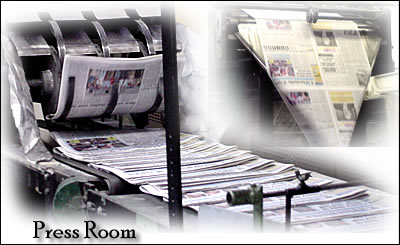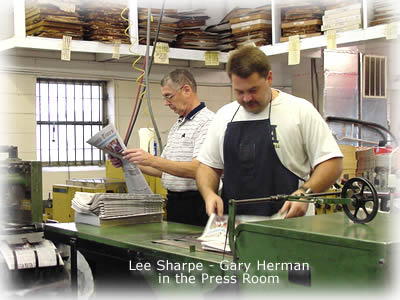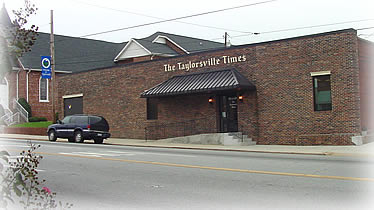Taylorsville, NC 28681 - 828-632-2532
Email the Times Office............Visit our website

The
Taylorsville Times has enjoyed a rich and interesting history of
service to the community of Alexander County since 1886.
Today, under the leadership of Walter Lee Sharpe, Publisher, and Jane
F. Sharpe, Associate Publisher, The Taylorsville Times continues
to serve as the community newspaper for our county.
On
Wednesday afternoons, folks begin picking up their weekly newspapers to
get up to date on local news, community events and more. The midweek publication
is also mailed to thousands of subscribers in and out of the area. The
Taylorsville Times went online in October 1997 and introduced an
updated online edition early 2002.

![]()
The Taylorsville
Times currently uses what is called desktop publishing. The sequence
of events using desktop publishing is going from computer to film to plate.
![]() After
the stories have been written and the pictures have been taken, everything
is laid out on the computer. QuarkXpress is the software many publishers use
because it allows for an entire paper to be put together on the computer.
After
the stories have been written and the pictures have been taken, everything
is laid out on the computer. QuarkXpress is the software many publishers use
because it allows for an entire paper to be put together on the computer.
![]() After
everything is put into place, the next step is to transfer what is on the
computer onto film. This works by sending everything to the RIP program, which
transfers the material to an image setter where a red laser burns the images
onto the film.
After
everything is put into place, the next step is to transfer what is on the
computer onto film. This works by sending everything to the RIP program, which
transfers the material to an image setter where a red laser burns the images
onto the film.
![]() Next, the film comes out and is sent through a processor. This part of
the process is very similar to how a photo center processes people's personal
pictures. Now that the material has gone from the computer to the film,
the next step is to put it onto the aluminum plate. This works by laying
out an unexposed plate on the vacuum frame of the NuArc Platemaker and
placing the film on top of it. A lid covers the film and the plate and
seals it with a vacuum to get rid of any air pockets.
Next, the film comes out and is sent through a processor. This part of
the process is very similar to how a photo center processes people's personal
pictures. Now that the material has gone from the computer to the film,
the next step is to put it onto the aluminum plate. This works by laying
out an unexposed plate on the vacuum frame of the NuArc Platemaker and
placing the film on top of it. A lid covers the film and the plate and
seals it with a vacuum to get rid of any air pockets.
![]() A
light shines through the negative and onto the plate, placing the image
onto the plate. Finally, the plate is sent to the press, and the paper
is printed.
A
light shines through the negative and onto the plate, placing the image
onto the plate. Finally, the plate is sent to the press, and the paper
is printed.
The Taylorsville Times continues to explore new equipment and methodologies which can improve its products. The next step that The Times will be going to is filmless production. This new technology allows production to go from computer to plate, eliminating film altogether.
|
Since 1930, the Sharpe family has played a major role in The Taylorsville Times success. Conway Sharpe, father of Lee Sharpe, joined the Times staff in 1930 as a linotype operator. He became co-publisher with Rom L. Teague in 1935, and Conway Sharpe continued as co-publisher until his death in 1962. Conway's wife, Irene Hendren Sharpe continued her husband's work as co-publisher with Teague. In 1964, Walter Lee Sharpe joined The Times ownership, purchasing half of his mother's interest in the paper. The three worked together until Teague's retirement at the end of 1974, at which point he sold his 50% interest to Walter Lee Sharpe. Irene Sharpe retired as co-publisher in 1999. In 1981 Jane Fox Sharpe entered the business working in the editorial and business areas of the paper. Prior to joining The Times, Jane had been an English teacher at Alexander Central High School for a number of years. Today Walter Lee Sharpe is publisher, and Jane F. Sharpe is associate publisher of The Taylorsville Times. |


Publisher
Associate Publisher
